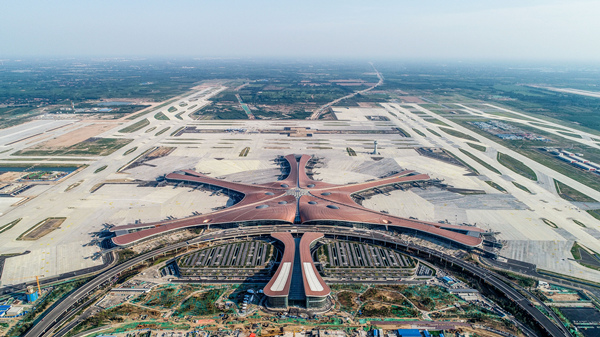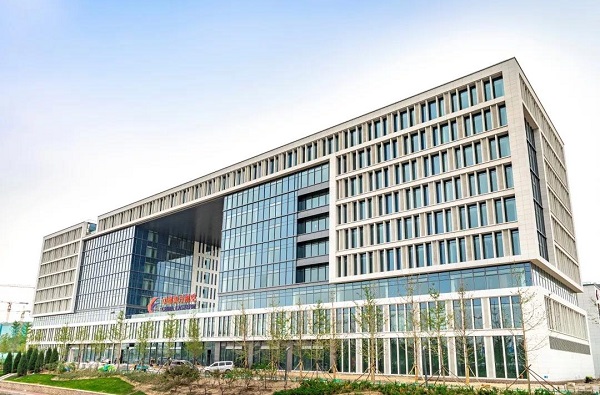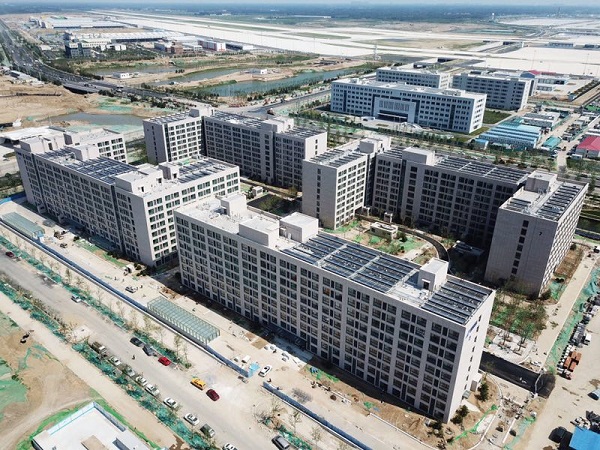Chinese Central SOEs Participate in Construction of Beijing Daxing International Airport
Most of the constructions of the Beijing Daxing International Airport, dubbed as "the Golden Phoenix", were completed on June 30.
All the completed projects passed the inspection test, meaning the airport is ready for operation.
Building of the flight areas started in December 2014 and construction of the core terminals fully began in September 2015.
The main projects include the major parts of the airport, airline bases, aviation fuel pipes, highways, intercity railways, high-speed subway lines and other supporting facilities.
Many Chinese central SOEs participated in the construction of the airport.

Main construction of the Beijing Daxing International Airport, also known as "the Golden Phoenix", is completed on June 30. [Photo by Wang Hao/CCCC Second Harbor Engineering Company Ltd.]
China Eastern Air Holding Co.Ltd (CEA)
The airline base of CEA at Beijing's new airport covers 930 mu (62 hectares) and is valued at 13.2 billion yuan ($1.93 billion). Construction of the first phase of the base started on June 29, 2017 and the second phase began on March 16, 2019.
All five parts of the first phase construction including the core working area, the service zone, the freight zone, areas for aircraft and special vehicles maintenance and the in-flight catering and ground service zones were ready for service after passing inspection on June 26, 2019.
According to the company, CEA has a total of 105 seats in the operation command center.
The base features different kinds of operation and command systems including a core decision-making zone, a flight release zone, a flight allocation zone, a plane resource area and an operation supporting area, through which staff members can obtain various kinds of information such as operating data, dynamic weather information and positions and movements of the planes in real time.

First phase of CEA's core working zone project [Photo/sasac.gov.cn]
The base is now accessible to internet and electricity and is ready for flights.
In addition to the preparation work, the company also contributed to other services including developing high-quality airline routes, guaranteeing sound and safe operations and improving traveling experience.
For instance, CEA has made a fast transition plan that proposes the new "360" operation mode. According to the mode, advanced technological measures like 5G communication technology, the internet, the Internet of Things and big data will be used in chain of guaranteed service - sales, self-service, baggage check-in, manufacturing guarantees, data interaction and behavior analysis.
Meanwhile, the company will carry out a high-quality service of self and intelligent travel which will be supported by 75 self check-in machines and 82 self baggage check-in devices.
China Southern Airlines Co., Ltd. (China Southern)
China Southern's airline base construction projects included aircraft maintenance facilities, dormitories for shift work, air catering facilities, houses for flight operations and safeguards and freight transport zones.
The five functional zones, covering nearly 1.09 million sq m, were built in several phases. The construction area of the first phase was 878,700 sq m with 31 individual buildings.
To develop projects in a high-quality, safe, clean-fingered and model way, the company used the world-wide recognized BIM technology which collected all the engineering data for designs and constructions into a 3D information database. It will continue to adopt the method for future maintenance.
The method improves efficiency and lowers costs and risks during construction.

China Construction First Group Corporation Limited builds China Southern's air catering facility project, the largest of its kind in the world. [Photo/sasac.gov.cn]
In addition, China Southern innovated and optimized the engineering technologies and applied for 17 patented technologies during the project.
The company will offer green, intelligent and technological travel service for passengers.
According to the company, 13 air routes and 28 flights will start operation at the new airport on Oct 27 this year. It is estimated that 40 percent of the Daxing International Airport's passengers will be carried by China Southern.
China State Construction Engineering Corporation (CSCEC)
Several subsidiaries of China State Construction Engineering Corporation (CSCEC) such as China Construction First Group Corporation Limited, China Construction Second Engineering Bureau Ltd., China Construction Third Engineering Bureau Co., Ltd, China Construction Eighth Engineering Division. Corp. Ltd, China Building Decoration and China Construction Steel Structure Corp. Ltd. participated in the construction of the new airport.
The companies undertook the construction of the heat source project, a sewage treatment plant, municipal construction of roads and bridges and pipe work, utility tunnel, elaborate decoration of terminals, parking lot, public rental apartment for talents and airlines' social service facilities.
China Construction First Group Corporation Limited shouldered China Southern's air catering facility project which is the largest of its kind in the world. The air catering center covers 95,000 sq m and will be home to eight of the most advanced air food production systems in the world. About 65,000 meals will be produced per day when the center goes into operation.
The company is also responsible for construction of the freight transport zone of CEA's air base.
Covering 77,000 sq m, it will be the only international and domestic air logistics base of the new airport and will fill 35.75 percent of the handling capacity of the airport.
The 65,700 sq m housing construction and the road and municipal pipe project were also under China Construction First Group Corporation Limited's charge.
Last but not least, the company also completed the building of high-quality houses for 2,628 households whose homes were displaced for the new airport's construction by August 2018.
China Construction Second Engineering Bureau Ltd. participated in four projects of the new airport - municipal traffic construction, public rental apartment for talents and air bases of CEA and China Southern. The total building area covers about 623,900 sq m.
Two projects - the 004 section of the road and bridge and pipe network project and the construction of a terminal for business jets - were contracted by China Construction Third Engineering Bureau Co., Ltd.
Contracted by China Construction Eighth Engineering Division. Corp. Ltd, construction of the parking lot and the comprehensive service building began in May 2016.
Later, the company successively completed nine important projects which included construction of the core base of CEA in Beijing, the core working area for air traffic control, the comprehensive meteorological monitoring zone and the airport’s only independent civil air defense project, a ground-source heat pump (GSHP), a sewage treatment plant and the gas regulator station.
China General Technology (Group) Holding Co., Ltd
The company contracted its first project of the new airport in October 2017 and effectively pushed forward the construction of other engineering tasks such as dormitory construction, water supply lines, decoration of VIP passengers' rest rooms at the terminals, and construction of the pipe work of meteorological radar stations.

Dormitories constructed by China General Technology (Group) Holding Co., Ltd at the China Southern air base [Photo/sasac.gov.cn]
China Communications Construction Company Limited (CCCC)
No. 4 Engineering Co., Ltd. of CCCC First Harbor Engineering Co., Ltd. participated in the flying area project and its main missions included construction of parts I and II of the runway in the west, the soil surface area, a channel under the highway, the drainage project of the flying zone and the service facilities construction.
CCCC Third Highway Engineering Co., Ltd, CCCC First Highway Engineering Group Co., Ltd. and Road and Bridge International Co., Ltd. participated in building the expressway for the new airport which was one of the key projects in Beijing in 2016.
The expressway is part of the traffic network of the five North-South and two East-West roads.
The new express starts from about 450 meters east of the Tuanhe Bridge on South 5th Ring Road and ends at the north of the new airport. It is a 27.2-kilometer road with four lanes on each side. The designed speed is 100 to 120 kilometers per hour.
It is a shortcut between the new airport and the urban area of Beijing.
China National Aviation Fuel Group Limited (CNAF)
The aviation fuel project of the Beijing Daxing International Airport was the largest-invested program of CNAF and was a major concern of the company.
An aircraft refueling test was done on June 30 during the full pilot operation. The test showed that the fuel is qualified and the refueling procedures are normative.

CNAF contracts the aviation fuel project of the Beijing Daxing International Airport which is the largest-invested program of the company. [Photo/sasac.gov.cn]
Power Construction Corporation of China (POWERCHINA)
POWERCHINA Sinohydro Bureau 16 Co., Ltd. participated in the road construction of the flying area which started on Sept 18, 2015.
It is in charge of the northern section of the first runway west of the terminal which will be able to carry the world's largest types of aircraft.
The main engineering missions included pavement, earth and stone work, a drainage project, foundation treatment and construction of a sunken passage under the light belt and service facilities.
The company completed all its missions on April 30, 2019 and passed the inspection test.
During the construction, the company also completed scientific research in the three issues of slip-form paver's performance in thick road concreting, mechanical surfacing construction of the airport roads and IDBI engineering skills for civil airfield pavement.
Two airport standards on usage of steel mould trollies in civil airfield construction and building of mixing unit for airport construction were also set by the company and were later released.
China Energy Engineering Group Co., Ltd. (Energy China Group)
China Energy Engineering Group Planning and Engineering Co., Ltd. (CPE) participated in some power grid removal and restructure projects, the distributed photovoltaic (PV) power generation project and the construction of the new airport's 110 kV traction substation.
Construction of the 500 kV power grid removal and restructure project took five years with the restructured grid going into operation on Dec 26, 2018. That result guaranteed that the new airport would begin service on time.
Construction of the CPE-contracted distributed PV power generation project started in June this year and is expected to be completed this September. It will offer green energy to the airport.
The first phase of the new intercity rail line connecting Langfang East Station, the eastern Beijing-Hebei province border, and Beijing Daxing International Airport, the southern Beijing-Hebei province border, was also built by CPE.
The 39.3-kilometer line will call at four stops and will complete intercity rail networks in the Beijing-Tianjin-Hebei region, which will relieve any passenger transport pressure at the new airport.
China Tower Corporation Limited (China Tower)
Most of the construction of the mobile communication infrastructure, generally contracted by China Tower, was completed recently, providing full internet coverage for the new airport and for high-speed railways and expressways in affected areas.
China Tower made the most of the resources and developed a comprehensive construction plan which met the demands of the public communication network and the private municipal networks of five communication companies - China Mobile Communications Group Co Ltd, China Telecommunications Corporation, China United Network Communications Group Co, CAPITEK and Beijing JustTop Network Communication Co., Ltd - at the same time lowering the costs and improving building efficiency.
China Tower built small and micro base stations on the 95 high-pole lamps and other buildings at the airport and provided telecommunication enterprises with high-quality and full-coverage internet with a new type of indoors coverage technology.
In addition, 95 macro base stations were built on main roads around the airport and many are to be shared by two or three telecommunication companies, which lowered investment costs by more than 65 percent compared to constructing individual base stations.
Meanwhile, issues like types of base stations, power capacity and machine room resources have been planned and reserved in advance for 5G technology and other industrial services.
(Executive editor: Hao Wen)



